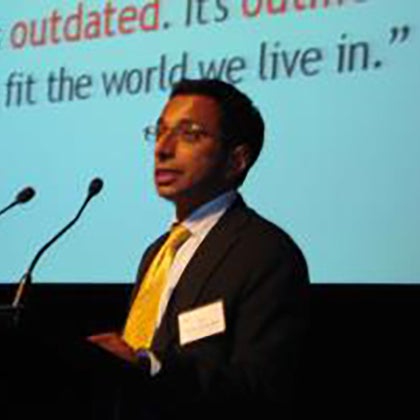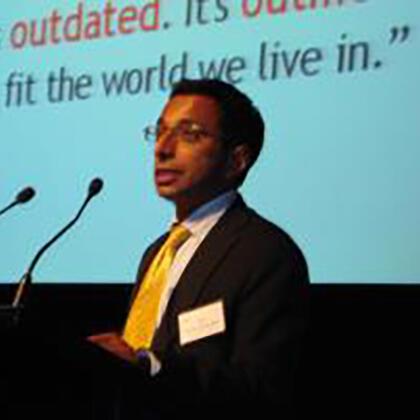The Enhanced Analytics Initiative
Share
- Details
- Transcript
- Audio
- Downloads
- Extra Reading
Research units of investment banks could be forgiven for thinking the world is an unfriendly place! First there was Elliot Spitzer, the reputational crisis and legal fines. Now there is an inexorable drift to unbundling. Even the SEC Chairman, William Donaldson, has weighed in about the short-termism and excessively narrow focus of analysts. So is the Enhanced Analytics Initiative, a project by major buy side clients to incentivise brokers to produce broader research of less tangible performance indicators, a welcome relief? Or is it yet more trouble, albeit well disguised? What do analysts need to do to compete, are they able to do so and who will be the winners? And if analysts really start to understand what drives corporate profitability, what impact will this have on corporations? Dr Raj Thamotheram is Chair of the Steering Committee of EAI and senior adviser to USS, the second largest corporate pension plan in the UK. He speaks and writes widely on issues related to responsible investing and corporate governance and was nominated by Global Proxy Watch, the newsletter of international corporate governance and shareowner value, as one of ten individuals who most influenced the shape of international corporate governance in 2004.
Download Transcript
THE ENHANCED ANALYTICS INITIATIVE:
INVESTING AS IF THE LONG-TERM REALLY DID MATTER
Dr Raj Themotheram
Thank you for the warm introduction. 400 years of famous speakers is a rather daunting act to follow! And I’m aware I’m a stand in for Avinash’s valedictory lecture. Perhaps he thought you, the audience, wouldn’t recognise! The good news is that you can hear both of us.
But in all seriousness, let me thank the College and Avinash for this honour. What I propose to focus on this evening is whether the investment chain is as “fit for purpose” as it needs to be. I should stress that I will be speaking in my personal capacity and not for USS or EAI but obviously, my thoughts are informed by my work in these organisations.
What I aim to do tonight is explain the ‘disconnect’ that I see between what pension fund members need and what the investment system is designed to deliver.
I’ll illustrate this with particular reference to the research link in the investment chain.
Then I’ll explain why I think focusing more on extra-financial issues is a good way forward, and I will tell you a bit about the why and how – and also the benefits – of a project called the Enhanced Analytics Initiative.
And finally, I’ll put this one specific project in a broader context of the changes I think needs to happen.
So…let’s start with this disconnect. There are two components to this. First, pension fund members want an absolute pension – pensioners can’t eat a relative pension! But as all of you who work in the system will know, the dominant focus is on relative returns and relative risks.
Second members assume that their pension promise equates to a reasonably predictable quality of retirement life. Indeed the pension fund product could be said to be an insurance against risk to quality of retirement life.
It’s widely understood that there are economic aspects to this promise (ie inflation) that need to be addressed (e.g. by indexing to wages). But retirement well-being is also a function of social and environmental capital. Corporations have strong market incentives to externalise costs on to society and the environment, and investors are a significant factor in this decision-making process. This externalisation of costs has significant implications for current retirees but it will have even bigger implications for future members – take climate change – so the inter-generational equity implications are very serious.
So whilst the customer may be king – at least in terms of trappings of power – the reality is that there is a paradox at the heart of our market based financial system. Customers at each point in the investment chain have less power when dealing with their suppliers than is the case in many other corporate sectors! It is true that there is a wide choice of different brands, but the product range vis-a-vis the ‘disconnects’ I talked about earlier is quite limited.
What trustees need are investment services and partnerships – not just products – that relate to liabilities, take a long-term view and address the real responsibilities of being an owner.
This disconnect is increasingly accepted by influential decision-makers and commentators. Two weeks ago, the SEC Chairman – perhaps knowing he was soon to retire – said the following:
“Over time, analysts have become obsessed with the question of whether a company meets its quarterly EPS [Earnings Per Share] numbers, and not with whether a company is built to last. And because of the considerable clout of the sell-side analyst, this shift from long-term-thinking to short-term results has echoed through to company managements and to professional investors.”
Why does the sell side analyst have so much influence? For a detailed account of how this influence works, I’d suggest you all read a Harvard Business Review article which was written in the form of a fictional letter from an experienced board member to a CEO. Its called “A letter to the Chief Executive” and let me just use one quote:
“What bothers me is that we seem to have lost control of the situation. We spend more time talking about what the analysts think we should earn than we do discussing what the company is capable of earning.”
There is good academic evidence for the negative impact on companies that Chairman Donaldson, the author of the HBR article and others have raised. One study found that from 1999-2004; nearly half of the companies in the Dow Jones Industrial Average always met consensus earnings estimates, or beat them by a penny. “Making the numbers” often results in unsound corporate strategies, which pay no regard to the cost of postponed investment; “Such a goal is often achieved only by bending accounting standards”, according to the SEC Chairman and who would be in a better position to know?
According to a recent National Bureau of Economic Research paper by academics from Duke University, of 401 senior financial executives surveyed, 78% said they would sacrifice an initiative they expected would create economic value if it would negatively impact on their ability to smooth earnings.
Chairman Donaldson could have also mentioned the impact on society. When company management are heavily focused on meeting analyst expectations, they have strong incentives to externalise costs wherever possible on to customers, employees, the environment and future generations. Let me quote what the Business Council of Australia – the equivalent of our CBI - has concluded:
“interviews with leading corporate managers, investors and other major participants suggest that short-termism is increasingly a driver of market behaviour and a potential constraint on longer-term value creation”
And the results?
“we are discounting the benefits that result from long-term thinking and strategic planning, and not adequately planning and investing for our future” and that “… Australia ’s ability to sustain economic growth, and thereby sustain individual well-being and quality of life over time is likely to be compromised”.
The challenge of market short-termism is a global one. Here in the UK, the Myners review process has started to address this issue.
So what is the answer? Let’s start with what isn’t needed! There is endless potential for a “blame game” between company management, analysts and the buy side about who is most responsible for short-termism. Notice how I put asset owners happily outside this ménage a trios – after all, we are just bystanders! But seriously, each constituency has its own role to play – for example, company reporting on extra-financials needs to improve significantly, as does the capacity of auditors to provide assurance on these new issues.
I am in the investment industry and so let me focus on what investors can do. In my opinion, the key change the investment system can make is to become a lot more professional at dealing with extra-financial issues – also known as intangibles, corporate risks and long-term value drivers. We don’t all yet use the same words but we know what we mean – fundamentals that have the potential to impact companies' financial performance or reputation in a material way, yet are generally not part of traditional fundamental analysis.
Extra-financial issues typically include, but are not limited to, corporate governance, employment standards, human resources, executive remuneration, environmental and social areas and reputation risk. They may be specific to a company, an industry or cut across several industry-groups – climate change being a good example of the latter. The consideration and evaluation of all risks, including material extra-financial risks, is important if client investments are to remain protected. These extra-financial issues clearly affect a company’s ability to enhance shareholder value, drive competitive advantage and generate sustainable returns over the long-term. Why? Because these are the issues which often define how a company will be positioned vis-a-vis its peers over the medium and longer term.
The good news is that the investment world is changing. This evidence comes from Mercers, the global investment consultants. They surveyed over 200 investment professionals around the world and they found that in all regions bar one, a majority of these investors think these extra-financial issues will become part of the “day job” sometime in the next 10 years. In Europe, for example, you see many professionals think it will happen in the next 1-2 years. Interestingly in the States, you see the majority think it will “never” happen. As an aside, this is interesting investment belief or worldview – how many other issues can you think of like this where investors would be so bullish to predict “never”?
So this is where the Enhanced Analytics Initiative (EAI) comes in. It is a project designed to ease this development along and help the market orient more towards the long-term. It does this by making sure fund managers are equipped with better research about the future prospects of industry sectors and the companies operating within them.
EAI is a consortium of asset owners and fund managers designed to give research houses a commercial incentive to produce innovative and differentiated research that captures and integrates the value of corporate performance on extra financial issues and integrate this into mainstream research notes. Put simply, it encourages analysts to comment on all material risks in their research outputs.
The specific commitment is to redirect a minimum of 5% of brokerage commission budgets to research houses that are effective at analysing material extra-financial issues. Based on the current group composition – and that is AGF Asset Management, BNP Paribas Asset Management, Deutscher Investment Trust / Dresdnerbank Investment Management, Generation Investment Management, London Pension Fund Authority, Mistra, PGGM, RCM, SNS Reaal Group, TUC Superannuation Society, and the Universities Superannuation Scheme – the total amount set aside for this project is likely to be in the order of €8 million for the year 2005. That is not an insignificant carrot and we are less than a year old! What we don’t stress is that some of us are also rationalising our research supply chains and this is one factor that may be taken into account when deciding which brokers to let go of.
So what are the benefits of this initiative? Let me start with an independent view from Mercers: “We think it is an innovative approach which differs from others under the broad “SRI umbrella”, in that EAI targets the mainstream, sell-sell segment of the investment community.”
Let’s consider the specific benefits and start with the top of the investment chain. Asset owners who are paying for active management – in the hope of finding alpha – have a particular interest in knowing that their managers have the best information feeds that they can get. After all, it is our client money that is being spent on brokers! And just because an individual analyst does not share the pain when the analyst community as a whole misses an issue – when it conveniently becomes called “exogenous” – that’s really not good enough.
And for asset owners who have a significant passive allocation – who depend on beta – EAI adds value in the same way that herd immunity and other public health strategies contribute to personal health. Passive investors have a strong interest in seeing the gap between market price and true fair value close and that risk and reward be more accurately priced in across their diversified portfolio. When this does not happen, it is the end beneficiaries and plan sponsor who pick up the tab. As research stimulated by the EAI becomes more common, market efficiency should improve. And as analysts focus more on the real fundamentals, it will increase incentives for better enterprise risk management and reduce the incentives for bubbles. All this should help increase positive externalities and reduce negative externalists and as investors who own a share of the universe – what is becoming known as universal investors - we will pick up our share of these welcome changes. Put simply, EAI should help, perhaps in a small way, to move the index in the right direction!
So asset owners have a strong case for supporting EAI and are increasingly joining as “associate members.” Several have already made public their intention to consider membership of EAI as one criterion in future mandates and beauty parades.
Moving down the investment chain, fund managers therefore have strong reasons for wanting to join EAI. Finding new ways to avoid risk, new sources of alpha (or at least avoid “negative alpha”), and help with new activities (for example, engagement and active ownership responsibilities). Let me give you just one example. Fund managers are coming under increasing pressure to show that they consider whether a remuneration deal is aligned with business strategy and targets. But the research data to make for such informed judgments is more or less lacking! So these are some of the reasons why fund managers have joined EAI so far. Obviously, membership makes most sense for those managers who take a fundamental and long-term investment approach. In joining EAI, fund managers are also saying that they have the confidence to acknowledge that trust in investment intermediaries is at a low point. And that where it is possible to better align internal processes – eg how client money is spent on research – with end beneficiary interests, then they are willing to overcome the internal cultural obstacles to change.
The benefits don’t stop at the buy-side. Good analysts much prefer doing interesting and intellectually challenging work than the repetitive, mechanistic commentary on last quarters figures. Perhaps more importantly from a corporate perspective, at a time when the analyst business model is being squeezed by regulatory attention and moves to unbundling – succinctly captured by the McKinsey report title “More relevant research at lower cost” – EAI represents a clear statement by a growing pool of international clients who are clear about what they are happy to pay for!
And finally there are the benefits for company management who can expect to deal with analysts who understand the long-term issues that they are juggling.
So if it so beneficial for so many, why has it not happened already? As with any market failure, it is possible to compete on the back of this failure and still win – arguably exacerbating or at least do nothing to correct the failure. EAI doesn’t take away competition but as with any initiative that increases transparency and efficiency, it does change the rules of the game a bit and will therefore influence who wins and who looses.
But above all, we all know how difficult change is. For those of you who are not aficionados of the investment process, let me say that, the relationships between a portfolio manager and his/her broker is second in terms of sensitivity only to his or her personal bonus! Hence it is not surprising that not all fund managers have joined EAI yet!
But that is what is needed for EAI to really succeed. More and more asset owners and fund managers are needed to swell the size of the 5% pot. The good thing about this sector is that it does benchmark its performance so I expect we will see more and more choosing to show leadership on this issue. Indeed EAI will be announcing a well known new member in the near future.
But don’t get me wrong, EAI isn’t a magic bullet for re-orienting the investment chain towards long-term and responsible investing. Other things are needed and I’d be happy to comment on these in questions. But you have to start somewhere! Asking fund managers what steps they have taken to secure systematic and quality coverage of extra-financial issues, and coverage of a kind that their analysts make regular use of – and also making sure they can evidence this – is a good first step for pension funds and their advisers to push for.
These and the other changes that are needed may take some effort and time to deliver but pension fund members have very real expectations about the quality of retirement life that they can expect. We shouldn’t deal with these responsibilities lightly.
© Dr Raj Themotheram, Gresham College, 2 June 2005
This event was on Thu, 02 Jun 2005
Support Gresham
Gresham College has offered an outstanding education to the public free of charge for over 400 years. Today, Gresham plays an important role in fostering a love of learning and a greater understanding of ourselves and the world around us. Your donation will help to widen our reach and to broaden our audience, allowing more people to benefit from a high-quality education from some of the brightest minds.


 Login
Login







